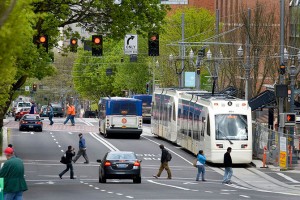by James A. Bacon
A new paper published by the conservative Free Congress Foundation makes the connection between mass transit and the economic vitality of American regions. Author Michael S. Bronzini, with George Mason University, argues that mass transit is needed to support a population shift back to walkable urban communities, which is being driven by the economics of the knowledge economy and the spread of popular urban design concepts such as planned communities and New Urbanism.
For the first time since World War II, Bronzini notes, Americans are driving less. The shift reflects the rising cost of automobile ownership and long-term demographic trends and preferences. “Metropolitan transportation investment is needed to support urban revitalization,” he writes in, “Transportation and the Economic Health and Attractiveness of Metropolitan Regions.”
Shifting urban housing and travel choice patterns, the increasing difficulty of building new major urban highways, and increasing urban population density mean that much new transportation investment will be in public transportation systems.
Investments in public transportation will have a broad array of social and economic benefit, including direct cost savings by riders, congestion cost savings for those driving on urban roadways, and improved business productivity and growth. Transit also helps to sustain and increase property values, and there is some evidence to suggest that cities with good public transportation fare better during economic downturns.
Bronzini does a fine job of summarizing a wide range of thinking and literature on the connection between transportation and regional vitality, and for the most part I found his reasoning impeccable. My quibble with his paper is that not the topics he addresses but those that he leaves out.
I agree entirely that mass transit is desirable infrastructure for U.S. regions of a certain size and density (roughly speaking, the 50 largest regions in the country), and that the benefits Bronzini describes are real. I even agree with his broad conclusion that greater investment in mass transit is a necessity. What Bronzini does not tell us in this paper is how to separate the wheat from the chaff. Which mass transit projects should we invest in? And how do we pay for them?
Without further elaboration, Bronzini’s point of view differs little from that of liberals, progressives and pragmatists who are happy to lavish money indiscriminately upon transit on the grounds that transit, generically speaking, is socially and economically beneficial. The problem is that mass transit, as currently structured in the United States, is not financially self-supporting and represents an ongoing drain on the public treasury. The same can be said of roads and highways, of course. But fiscal malpractice in one does not justify fiscal malpractice in the other.
Any cry for more spending on mass transit must be accompanied by an insistence that all transportation projects — roads, rail, transit — compete on a level playing field, which means implementing a user/beneficiary-pays financing system for both that that covers capital construction, operations and maintenance. In effect, we would build only projects for which there is a demonstrated market demand. Conservative embrace of mass transit also should acknowledge that the current mass-transit model is broken and its successful implementation requires reform of land use policies, urban design, labor featherbedding practices, political interference on route structures, counterproductive federal regulation and other ills.
Hopefully, those are themes that Mr. Bronzini and/or the Free Congress Foundation intend to develop in future studies.



